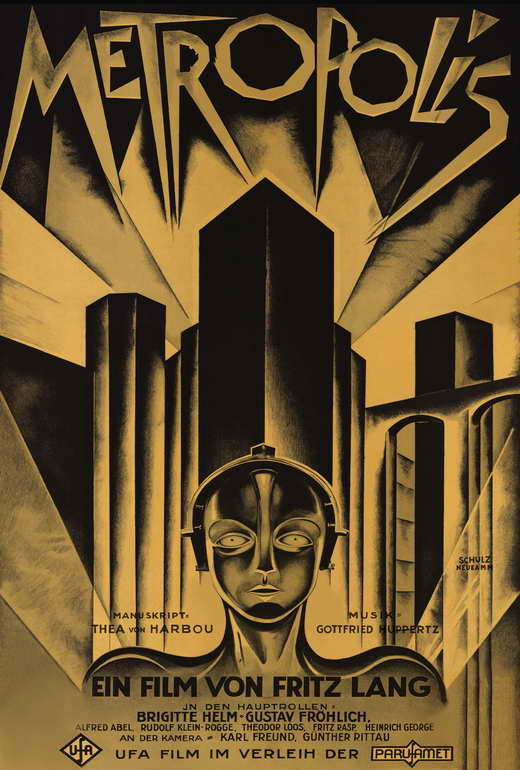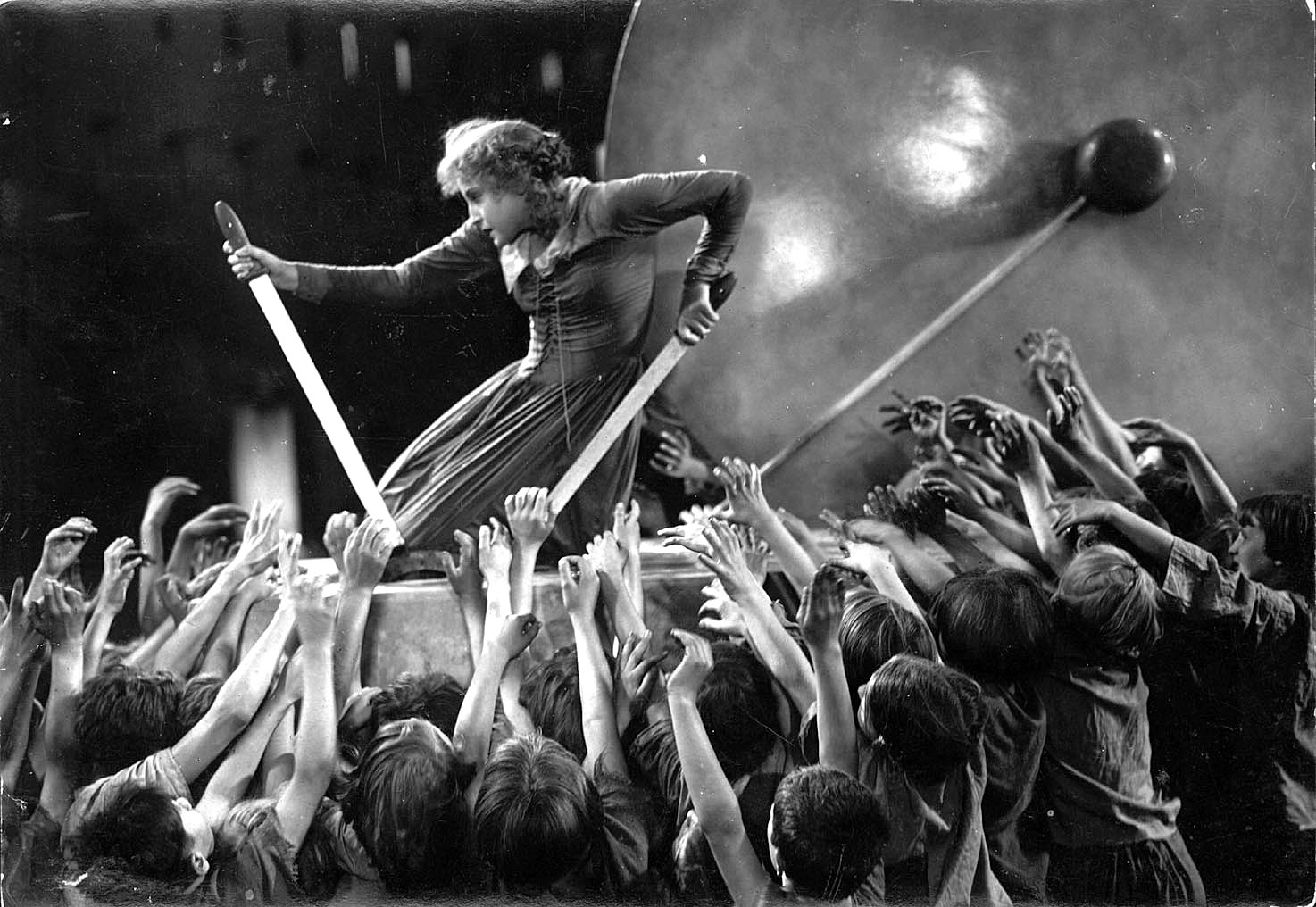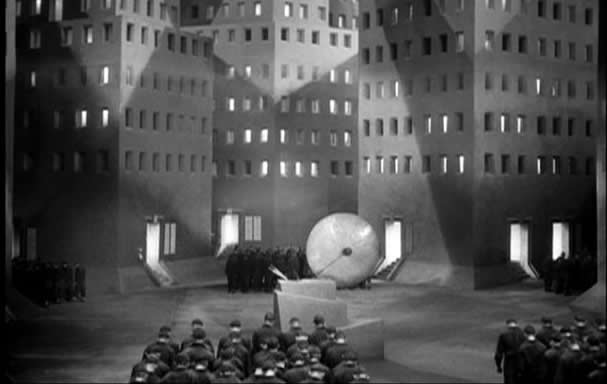
Fig 1. Metropolis Poster
Metropolis, a city filled with utopian ideals of the age. Its monumental skyscrapers support sky-bridges for the transport needs of its wealthy inhabitants, and its dazzling superstructures seem beyond anything that human hands could build. This is the image on the surface but as Freder (the protagonist) discovers, there is a secret behind this perfect city. Immense machines keep the city alive, these machines are kept breathing themselves by an army of labour workers, that are pushed to their human limits by the masters who control metropolis. These workers move as the machines do, in complete synchronicity with one another, their faces drained of all emotion from the endless hours toiling at the great machines (See Fig 2.).

Fig 2. Metropolis Workers
After Freder is confronted with this harsh reality he seeks to help, and after working among these people he finds Maria, a woman who seeks to join the workers to the people in power through use of a mediator (Freder). After many twists and turns in the plot, which temporarily halt Freder and Maria's progress with this plan, the machines are destroyed and a complete shut-down of the city follows. There is much chaos and confusion which is eventually quelled and through Freder, the workers and the people in power are able to see how much they need each other.
''For its time, the film was a milestone, innovative miniatures and camera tricks to create its city of the future, taking two years to shoot and bankrupting its producers.'' (Wise, 2010) Perhaps it is because of all the innovative tools that were used, and in such interesting and eye-catching ways, that this film became a milestone for film production. It seems more likely though, that the culmination of those, combined with a strong plot with a bold political message was simply a recipe for success at the time. The fact that so much time was spent on shooting and that so much money was used on this film, clearly shows that everyone involved in the making of this film had a real passion for it.

Fig 3. Maria and the Workers Children
In many of the scenes people make up a lot of the space, as Urgosikova states in his review on Filmreference.com, ''Lang also shapes space with the help of human bodies and uses light in accordance with the principles of expressionism.'' (Urgosikova, s.d.) Whether early on with the shift changing of the workers (See Fig 2.) or much later in the film, when the workers city is flooding and children are attempting to escape the treacherous waters (See Fig 3.), people are used almost instead of environment to draw your eye into a scene.
Some interesting camera-work is used in a certain scene, when Freder is in the basement of Rotwangs cottage, he reaches for a piece of cloth and the camera follows his hand as he reaches for it. When considering many of this films other camera shots, this stands out very boldly and can be spotted very easily by the audience.

Fig 4. The New Tower of Babylon
At times, when the camera shows the city in full working order (See Fig 4.), it is clear to see the ingenuity behind the design and the time it must have taken to get these scenes correct. When confronted with scenes of the city, mixed with scenes of the workers city deep underground (See Fig 5), there is a real clash between the imagery shown.

Fig 5. The Workers City
A sentence that seems to best describe this clash of cities, is a quote from Kim Newman in her review from Empireonline, ''Vast skyscrapers full of Jazz-Age decadents tower above an underground hell of workers strapped to torture machines.'' (Newman, s.d.)
Illustration List
Lang, F (1927) Figure 1. Metropolis Poster. http://images.moviepostershop.com/metropolis-movie-poster-1926-1020433586.jpg (Accessed on 02/10/14)
Lang, F (1927) Figure 2. Metropolis Workers. http://forthepaperbag.files.wordpress.com/2011/01/m
etropolis_drones.jpg (Accessed on 02/10/14)
Lang, F (1927) Figure 3. Maria and the Workers Children. http://moviemezzanine.com/wp-content/uploads/metropolis-lang-3.jpg (Accessed on 03/10/14)
Lang, F (1927) Figure 4. The New Tower of Babylon. http://michaelgloversmith.files.wordpress.c
om/2010/11/metropolis1.jpg (Accessed on 03/10/14)
Lang, F (1927) Figure 5. The Workers City. http://www.tboake.com/dystopia/patterson/images/
METROPOLIS_USA_NTSC-45.jpg (Accessed on 03/10/14)
Bibliography
Wise, D (2010) http://www.theguardian.com/film/2010/oct/21/metropolis-lang-science-fiction (Accessed on 03/10/14)
Urgosikova, B (s.d.) http://www.filmreference.com/Films-Ma-Me/Metropolis.html (Accessed on 03/10/14)
Newman, K (s.d.) http://www.empireonline.com/reviews/reviewcomplete.asp?DVDID=4818 (Accessed on 03/10/14)
Urgosikova, B (s.d.) http://www.filmreference.com/Films-Ma-Me/Metropolis.html (Accessed on 03/10/14)
Newman, K (s.d.) http://www.empireonline.com/reviews/reviewcomplete.asp?DVDID=4818 (Accessed on 03/10/14)

A thoughtful review Jack; and it flows much better now that you are embedding the quotes :)
ReplyDeleteJust one little point - when you put your bibliography together, the names go in alphabetical order, so your list in this case would be Newman, Urgosikova and Wise.